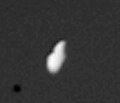
Telesto is a moon of Saturn. It was discovered by Smith, Reitsema, Larson and Fountain in 1980 from ground-based observations, and was provisionally designated S/1980 S 13. In the following months, several other apparitions were observed: S/1980 S 24, S/1980 S 33, and S/1981 S 1.
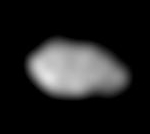
Metis, also known as Jupiter XVI, is the innermost known moon of Jupiter. It was discovered in 1979 in images taken by Voyager 1, and was named in 1983 after the first wife of Zeus, Metis. Additional observations made between early 1996 and September 2003 by the Galileo spacecraft allowed its surface to be imaged.

Atlas is an inner satellite of Saturn which was discovered by Richard Terrile in 1980 from Voyager photos and was designated S/1980 S 28. In 1983 it was officially named after Atlas of Greek mythology, because it "holds the rings on its shoulders" like the Titan Atlas held the sky up above the Earth. It is also designated Saturn XV.

Helene is a moon of Saturn. It was discovered by Pierre Laques and Jean Lecacheux in 1980 from ground-based observations at Pic du Midi Observatory, and was designated S/1980 S 6. In 1988 it was officially named after Helen of Troy, who was the granddaughter of Cronus (Saturn) in Greek mythology. Helene is also designated Saturn XII (12), which it was given in 1982, and Dione B, because it is co-orbital with Dione and located in its leading Lagrangian point (L4). It is one of four known trojan moons.

Tethys, or Saturn III, is a mid-sized moon of Saturn about 1,060 km (660 mi) across. It was discovered by G. D. Cassini in 1684 and is named after the titan Tethys of Greek mythology.
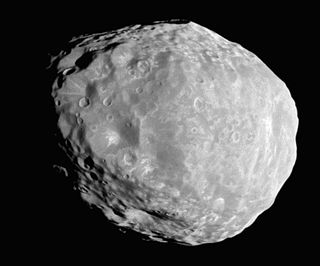
Janus is an inner satellite of Saturn. It is also known as Saturn X. It is named after the mythological Janus.

Epimetheus is an inner satellite of Saturn. It is also known as Saturn XI. It is named after the mythological Epimetheus, brother of Prometheus.
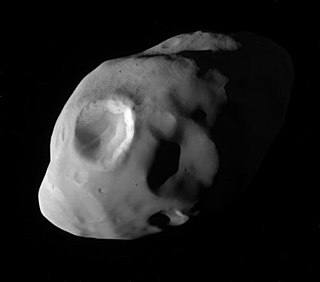
Pandora is an inner satellite of Saturn. It was discovered in 1980 from photos taken by the Voyager 1 probe, and was provisionally designated S/1980 S 26. In late 1985 it was officially named after Pandora from Greek mythology. It is also designated Saturn XVII.

Dione, also designated Saturn IV, is the fourth-largest moon of Saturn. Its trailing hemisphere is marked by large ice cliffs called chasmata and is also darkened compared to the leading hemisphere. Based on its density, Dione’s interior is likely a combination of silicate rock and water ice in nearly equal parts by mass. The moon was discovered by Italian astronomer Giovanni Domenico Cassini in 1684 and is named after the Titaness Dione in Greek mythology.

Prometheus is an inner satellite of Saturn. It was discovered in 1980 from photos taken by the Voyager 1 probe, and was provisionally designated S/1980 S 27.

The timeline of discovery of Solar System planets and their natural satellites charts the progress of the discovery of new bodies over history. Each object is listed in chronological order of its discovery, identified through its various designations, and the discoverer(s) listed.

Themisto, also known as Jupiter XVIII, is a small prograde irregular satellite of Jupiter. It was discovered in 1975, subsequently lost, and rediscovered in 2000.

The moons of Saturn are numerous and diverse, ranging from tiny moonlets only tens of meters across to the enormous Titan, which is larger than the planet Mercury. There are 146 moons with confirmed orbits, the most of any planet in the solar system. This number does not include the many thousands of moonlets embedded within Saturn's dense rings, nor hundreds of possible kilometer-sized distant moons that were seen through telescopes but not recaptured. Seven Saturnian moons are large enough to have collapsed into a relaxed, ellipsoidal shape, though only one or two of those, Titan and possibly Rhea, are currently in hydrostatic equilibrium. Three moons are particularly notable. Titan is the second-largest moon in the Solar System, with a nitrogen-rich Earth-like atmosphere and a landscape featuring river networks and hydrocarbon lakes. Enceladus emits jets of ice from its south-polar region and is covered in a deep layer of snow. Iapetus has contrasting black and white hemispheres as well as an extensive ridge of equatorial mountains among the tallest in the solar system.

Skathi, also named Saturn XXVII and originally spelled Skadi, is a natural satellite of the planet Saturn. Skathi is one of Saturn's irregular moons, in its Norse group of satellites. It was discovered on September 23, 2000, by a team of astronomers led by Brett Gladman. The team announced their discovery on December 7, 2000, along with seven other satellites of Saturn, namely; Tarvos, Ijiraq, Thrymr, Siarnaq, Mundilfari, Erriapus, and Suttungr. The moon was named after Skaði, a figure in Norse mythology, as part of an effort to diversify the largely Greek and Roman names of astronomical objects.

Ymir, or Saturn XIX, is the second-largest retrograde irregular moon of Saturn. It was discovered by Brett J. Gladman, et al. in 2000, and given the temporary designation S/2000 S 1. It was named in August 2003 after Ymir, who in Norse mythology is the ancestor of all the Jotuns or frost giants.
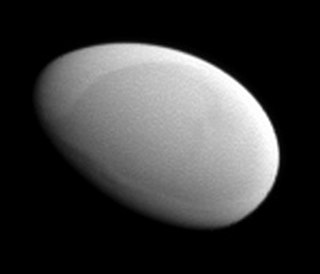
Methone is a small, egg-shaped moon of Saturn that orbits out past Saturn's ring system, between the orbits of Mimas and Enceladus. It was discovered in 2004, though it wasn't until 2012 that it was imaged in detail by the Cassini spacecraft.

Pallene is a very small natural satellite of Saturn. It is one of three small moons known as the Alkyonides that lie between the orbits of the larger Mimas and Enceladus. It is also designated Saturn XXXIII.
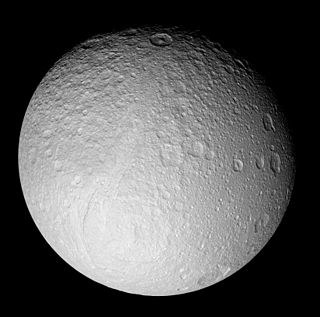
Ithaca Chasma is a valley (graben) of Saturn's moon Tethys, named after the island of Ithaca, in Greece. It is up to 100 km (62 mi) wide, 3–5 km (1.9–3.1 mi) deep and 2,000 km (1,200 mi) long, running approximately three-quarters of the way around Tethys' circumference, making it one of the longer valleys in the Solar System. Ithaca Chasma is approximately concentric with Odysseus crater.

Polydeuces, also designated Saturn XXXIV, is a small trojan moon of Saturn occupying the trailing L5 Lagrange point of Dione. It was discovered by the Cassini Imaging Science Team in images taken by the Cassini space probe on 21 October 2004. With a mean diameter of about 3 km (1.9 mi), Polydeuces is thought to have a smooth surface coated with fine, icy particles accumulated from the cryovolcanic plumes of Enceladus. In its orbit around Saturn, Polydeuces periodically drifts away from Dione's Lagrange point due to gravitational perturbations by other nearby moons of Saturn. Of the four known trojan moons of Saturn, Polydeuces exhibits the largest displacement from its Lagrange point.
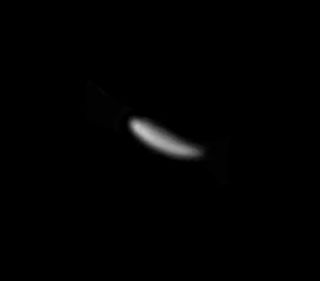
Aegaeon, or Saturn LIII, is a natural satellite of Saturn. It has an extremely elongated shape whose surface is thought to be similarly smooth as Methone. It orbits between Janus and Mimas within Saturn's G Ring.



